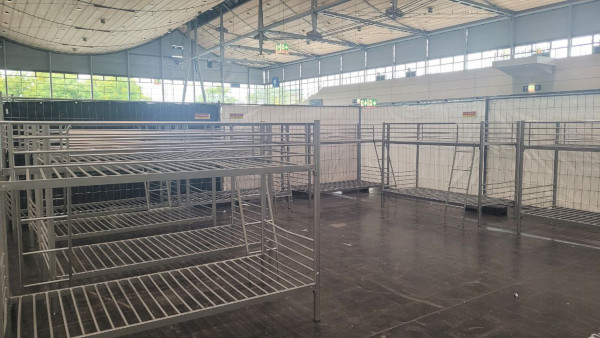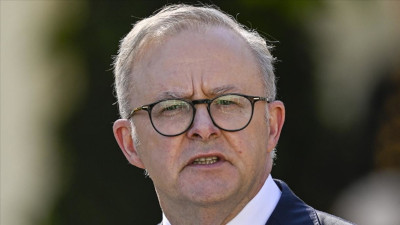President Biden and Vice President Harris believe everyone deserves to live in a safe and affordable home. Whether you rent or own, having a place to live that you can afford in a neighborhood with opportunities is the foundation for so much else in life. The Administration has made progress toward delivering this reality for the American people. The homeownership rate is higher now than before the pandemic, and there are more housing units under construction right now than at any time in the last 50 years, thanks in part to actions taken under this Administration. This increase in construction is contributing to a flattening rental market after years of increases.
But President Biden believes that housing costs are still too high for too many families and bold investments are needed to address the large deficit in accessible and affordable homes this Administration inherited. In his State of the Union Address, President Biden called on Congressional Republicans to end years of inaction and pass legislation to lower costs by providing a $10,000 tax credit for first-time homebuyers and people who sell their starter homes. The Budget includes that proposal as part of a historic investment of more than $258 billion that would build or preserve over 2 million housing units, support millions of first-time homebuyers, guarantee affordable housing for hundreds of thousands of extremely low-income veterans and youth aging out of foster care, and advance efforts to end homelessness.
Together, the Budget proposes investments and actions that will lower costs for renters and homebuyers, address the shortage of housing, make our economy stronger and more resilient, and advance equity, economic opportunity, and fair housing principles that are central to the President’s economic agenda.
Builds and Preserves More Than Two Million Housing Units
America faces a longstanding and nationwide shortfall in affordable housing that has been growing for decades. In May 2022, the Administration released a Housing Supply Action Plan that included administrative and legislative actions to close the housing supply shortfall in five years. The Administration has already delivered on many of those commitments, added new areas of focus including commercial-to-residential conversions, and will continue to build on the historic number of multifamily units under construction through additional administrative actions that: make it easier to build and preserve affordable, multifamily housing; advance the production and preservation of homes like accessory dwelling units and manufactured housing; and incentivize state and local governments to reduce barriers to affordable housing development. The President’s Budget:
Expands the Low-Income Housing Tax Credit (LIHTC). LIHTC is the largest Federal incentive for affordable housing construction and rehabilitation. The Budget invests $37 billion in expanding this tax credit in order to boost the supply of housing that is affordable for low-income renters. Specifically, the Budget permanently increases the allocation of tax credit states receive. It also reduces the private activity bond financing requirement from 50 percent to 25 percent in order to leverage more private capital into LIHTC deals and build more units of affordable housing. And it repeals the qualified contract provision and right of first refusal provision – both of which allowed some owners of LIHTC units to exit requirements to keep rents at affordable levels. These proposals would build or preserve 1.2 million affordable rental units.
Creates a New Neighborhood Homes Tax Credit. The Budget proposes a new Neighborhood Homes Tax Credit, which would be the first tax provision to directly support building or renovating affordable homes for homeownership. At a cost of $19 billion over ten years, the credit would cover the gap between the cost of construction and the sale price for rehabilitated or newly constructed single-family homes in low-income communities, encouraging investment in homes that would otherwise be too costly or difficult to develop or rehabilitate – and spurring investment and economic activity in communities that have long suffered from disinvestment. The tax credit would be provided on the condition that the home is occupied by low- or middle-income homeowners. This proposal would lead to the construction or preservation of over 400,000 starter homes in communities throughout the country.
Incentivizes More Housing Supply through Housing Innovation. The Budget includes $20 billion for competitive grants to incentivize State and local jurisdictions and tribes to expand supply. The grants will fund multifamily developments, including commercial-to-residential conversions and projects near transit and other community amenities; support planning and implementation grants to help jurisdictions identify and remove barriers to building more housing; launch or expand innovative housing models that increase the stock of permanently affordable rental and for-sale housing, including community land trusts, mixed-income public development, and accessory dwelling units; and construct and rehabilitate starter homes. This Budget also requests up to $100 million—$15 million over the FY23 enacted level—to continue the Pathways to Removing Obstacles to Housing program, which helps local governments to remove barriers to building more affordable housing.
Increases Banks’ Contributions Towards Building Affordable Housing. The President is proposing that each Federal Home Loan Bank double its annual contribution to the Affordable Housing Program, which will raise an additional $3.79 billion for affordable housing over the next decade and assist nearly 380,0000 households. These funds will support the financing, acquisition, construction, and rehabilitation of affordable rental and for-sale homes, as well as help low- and moderate-income homeowners to purchase or rehabilitate homes.
Preserves Public Housing through Rehabilitation and Redevelopment. Over 1.7 million Americans live in public housing, and over half of those households are led by seniors or people with disabilities. The Budget proposes a one-time a one-time $7.5 billion investment to address the capital needs of more than a hundred thousand distressed public housing properties nationwide, which is on top of the recurring annual investments of $8.5 billion to enable public housing agencies to operate, maintain, and make capital improvements to the approximately 900,000 public housing units. Providing additional funds for public housing rehabilitation and modernization is critical to providing safe and sustainable living conditions for all – and to ensuring housing shortages aren’t exacerbated.
Provides New Project-Based Rental Assistance (PBRA) for Extremely Low-Income households. Eleven million of the 44 million renter households in the U.S. have extremely low incomes—incomes at or below the Federal poverty level or 30% of the area median income. Producing and preserving housing that is affordable for those households—and ensuring rents remain affordable for those households—is a critical component of tackling the Nation’s housing challenges that often requires additional subsidy. The Budget includes $7.5 billion in funding for new HUD Project-Based Rental Assistance (PBRA) contracts, which are long-term contracts with private for-profit or non-profit owners to rent new affordable housing units. These new contracts, in combination with other low-income housing programs and incentives, will attract development capital for the creation of new affordable homes for America’s most vulnerable families.
Increases the Supply of Affordable Housing Financed by Existing HUD programs. During the Biden-Harris Administration, HUD has allocated $4.35 billion in funding to build and preserve affordable rental homes and make homeownership a reality for thousands of families. In collaboration with states, cities, local elected officials, stakeholder organizations, and local community development partners, HOME has assisted over 45,000 households since 2021. The Budget provides $1.25 billion for the HOME Investment Partnerships Program (HOME) to construct and rehabilitate affordable rental housing and provide homeownership opportunities. This investment would help create or preserve 12,000 units of housing and provide more than 6,000 households with tenant based rental assistance. In addition, the Budget provides $931 million to support housing for older adults and $257 million to support housing for persons with disabilities.
Supports Affordable Housing in Rural Areas. The Budget provides $2.1 billion for USDA’s housing programs, an increase of $191 million over the 2023 enacted level, and continues the proposal to eliminate the low-income borrower penalty that requires individuals to repay subsidy costs for Single-Family Direct loans. Housing funding reflects the Administration’s priority to preserve low-income multifamily (MF) housing in rural areas by increasing the MF Housing Preservation and Revitalization program to $90 million, $54 million over the 2023 enacted level, while maintaining the rest of the MF loan portfolio at the 2023 levels. The Budget also continues the proposal, known as decoupling, that incentivizes property owners to maintain property for low-income tenants in exchange for the continued federal rental assistance after the USDA loan is paid off.
The Administration also plans to explore updating the statutory definition of manufactured housing—for example, through amending the chassis requirement—with the goal of identifying options that could provide manufactured homebuilders with more design flexibility and consumers with more options beyond local site-built homes for single-family homes and accessory dwelling units.
Makes Homeownership a Reality for Millions of First-Time and First-Generation Homebuyers
Achieving and maintaining homeownership is the primary way that American families build wealth and create economic security. That’s why the Administration implemented a series of measures that protected homeowners from foreclosure during the pandemic, including enhanced loan modifications to resolve delinquencies. In addition, the American Rescue Plan’s Homeowner Assistance Fund has helped over 400,000 homeowners catch up on their mortgage payments and utility costs and avoid foreclosures. These actions have not just helped keep foreclosures below pre-pandemic levels, but have led there to be fewer foreclosures under President Biden than any President in recent history. In 2023, the Administration also lowered Federal Housing Administration annual mortgage insurance premiums by about one-third, saving more than 680,000 Americans—including many first-time homebuyers—an average of nearly $900 over the first year of their mortgages with continued savings in subsequent years.
But limited inventory and high interest rates continue to make it difficult to become a homeowner for the first time and prevent existing homeowners from right-sizing their house to fit their households’ evolving needs. That’s why the Budget calls on Congress to:
Provide Mortgage Payment Relief for First-time Homeowners. President Biden is calling on Congress to pass a Mortgage Relief Credit that would provide middle-class first-time homebuyers with a tax credit of up to $10,000, paid over two years. This is the equivalent of reducing the mortgage rate by 1.5 percentage points for two years on the median home, to help more than 3.5 million middle-class families purchase their first home over the next two years.
Provide Incentives to Unlock Starter Home Supply. Many existing homeowners have lower rates on their mortgages than current rates, making homeowners more reluctant to sell, even in circumstances where their current homes no longer fit their household needs. To unlock starter home inventory and allow middle-class families to move up the housing ladder and empty nesters to right size, the President is calling on Congress to provide a one-year tax credit of up to $10,000 to middle-class families who sell their starter home, defined as homes below the area median home price in the county, to another owner-occupant. This proposal is estimated to help nearly 3 million families.
Launch a First-Generation Down Payment Assistance Program. The Budget provides $10 billion for a program to target down payment assistance to first-time homebuyers whose parents do not own a home and are at or below 120% of the area median income or 140% of the area median income in high-cost areas. This would help an estimated 400,000 homebuyers. Eligible activities would include costs in connection with acquisition such as down payment costs, closing costs, and costs to reduce the rates of interest on eligible mortgage payments. The Budget also includes up to $50 million for a HOME Down Payment Assistance Pilot that would reduce mortgage down payments for first-generation as well as low-wealth first-time homebuyers.
Promotes Rental Affordability and Fairness, and Makes Progress Toward Universal Housing Vouchers for Extremely Low-Income Households
While around 2.3 million low-income households receive rental assistance through the HUD Housing Choice Voucher (HCV) program, another roughly 10 million are eligible and do not receive assistance due to funding limitations and wait lists. The Administration has secured rental assistance for more than 100,000 additional households through the American Rescue Plan and the 2022 and 2023 appropriations bills. And in January 2023, the Administration announced a Blueprint for a Renters Bill of Rights, which enumerated principles to shape Federal, state, and local action, and announced agency commitments to strengthen tenant protections and encourage rental affordability.
But there is more work to do. The Budget includes a voucher guarantee for two population groups that are acutely vulnerable to homelessness: youth aging out of foster care and extremely low-income veterans. Between discretionary funding, program reserves, and these mandatory proposals, these vouchers would serve hundreds of thousands of additional households. The President’s Budget:
Creates a Housing Voucher Guarantee for Extremely Low-Income Veterans. An estimated 398,000 veteran renter households with extremely low incomes currently do not receive rental assistance and have what HUD terms “worst-case housing needs.” These veterans: 1) have incomes that do not exceed the higher of the Federal Poverty Line or 30 percent of the Area Median Income; 2) either pay more than half of their income for rental costs or live in housing with severe problems such as faulty heating or plumbing; and 3) receive no housing assistance. Over a ten-year period, HUD would expand rental assistance to extremely low-income veteran families, starting with an allocation of 50,000 targeted vouchers in 2026 and paving a path to guaranteed assistance for all veterans in need by 2034.
Creates a Housing Voucher Guarantee for Youth Aging out of Foster Care. Approximately 20,000 youth exit foster care annually, typically between the ages of 18 and 21, and these young people face greater obstacles to maintaining housing and experience higher rates of homelessness and housing instability compared to the general population. To ensure these young people are stably housed and better able to focus on their education or building a career during this difficult transition, HUD would provide guaranteed housing voucher assistance for all youth aging out of foster care beginning in 2026.
Supports the HCV Program. The Budget provides $32.8 billion, an increase of $2.5 billion (including emergency funding) over the 2023 enacted level, and an increase of $7.0 billion, or 27 percent, since the start of the Administration.
Continues to Invest in Fair Housing Programs. The Budget includes $86 million for targeted and coordinated fair housing enforcement, education, and outreach to prevent and redress housing-related discrimination.
Advances Efforts to Prevent Evictions and End Homelessness
During the pandemic, the Administration stood up a first-of-its-kind national eviction prevention infrastructure, which helped 8 million renter households at risk of eviction and kept evictions below pre-pandemic levels. In late 2022, President Biden released All In: The Federal Strategic Plan to Prevent and End Homelessness. The Administration’s roadmap is not only about getting people into housing, but also ensuring that they have access to the support, services, and income that allow them to thrive. The plan focuses attention on homelessness prevention and actions to ensure an adequate and diverse stock of affordable housing, renter protections, and social service supports. The plan also seeks to promote and expand eviction-prevention reforms, including those advocated as part of the Biden Administration’s implementation of the Emergency Rental Assistance program. The Budget seeks to continue the policies that are most effective in preventing avoidable evictions and help hard pressed American families stay in their homes, even during hard times. The President’s Budget:
Bolsters Efforts to Prevent and End Homelessness. To prevent and reduce homelessness, the Budget provides $8 billion for a grant program to rapidly expand temporary and permanent housing strategies for people experiencing or at risk of homelessness. Funds from this proposal would support non-congregate emergency shelter solutions, interim housing, rapid rehousing, permanent supportive housing, and rental housing for extremely low-income households experiencing housing instability or homelessness. The budget also provides over $4 billion in Homeless Assistance Grants, a $427 million increase from the 2023 enacted level and $1.1 billion, or 35 percent, above the 2021 enacted level. In addition, the Administration plans to use approximately $100 million in program recaptures to fund coordinated interventions to support nearly 11,000 additional homeless individuals and families. The Budget also provides $505 million for Housing Opportunities for Persons with AIDS, serving a population with a disproportionately high rate of homelessness and providing a critical link to services.
Supports, Solidifies, and Encourages State and Local Reforms to Avoid Evictions. The Administration stood up a historic national eviction prevention infrastructure during the pandemic, helping keep eviction filings 20% below historical averages, even after the eviction moratorium ended. The Budget provides $3 billion to build on these efforts, with a focus on upstream prevention and eviction diversion, improving renters’ access to resources, and making the legal process for renters fairer. This funding can be used to develop or implement policy reforms and program improvements such as providing emergency rental assistance or other forms and new models of rent relief, and expanding access to legal counsel, housing counselors, and court navigators. The Budget also includes an additional $10 million for HUD’s Eviction Protection Grant Program, which provides legal assistance to low-income tenants at risk of or subject to eviction and has served over 25,000 households.
Creates More Housing Stability for Older Adults. To counteract the growing numbers of older adults who are experiencing homelessness or at risk of homelessness, the Budget includes a $3 billion grant program to help communities provide targeted support for older adults in unstable housing situations and support those currently experiencing homelessness. Eligible uses include short- or longer-term cash assistance to cover rental arrears or other housing costs to prevent eviction, emergency home modification or emergency relocations, provide resources to help cover unexpected financial shocks (e.g., medical/health costs), and other legitimate needs determined by the grantee.
###




